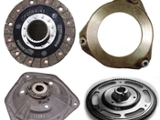If there's one subject that gets washed over when transplants or modifications are discussed its the flywheel and clutch assembly. There also seems to be a widely held belief that up-rating an engine from anything other than standard automatically requires a ‘competition clutch’. This, as with many other subjects concerning the Mini, is a myth. May be it’s because the prospective transplantee needs not only a bigger/more powerful engine to amaze folk with in the bar stool bullsh*t stakes, but also anything that can be dubbed with the word ‘competition’. ‘Up-rated’, after all, is a fairly tame word. Although many have written much about how to modify engines, some suspension, and even on bodywork, very little has been written about the flywheel and clutch. Bit strange as it’s an essential part of transferring engine power to the wheels! So let us delve into the myths and legends concerning this enigma of power transfer. In the clutch and flywheel articles I will go through what was, what is, what’s necessary, then how they are best used. I am not going to go into graphic description on how they actually perform as this would be extremely laborious in words.
A brief history…
In the very early years, the Mini was endowed with a spring-operated clutch. Adapted from in-line engine duty to suit the peculiar new ‘gearbox under engine’ configuration. It was OK for the 850 unit, though the oil-fed primary gear caused all sorts of problems with incurable leaks. Early competition Minis suffered most of their failures because of this. Various modifications were tried on subsequent production cars, including the first 1071cc Ss. By 1964 however, The BL design team concluded something else was needed. Enter the two-piece flywheel, then in about 1973 a one-piece version, both using a diaphragm mounted disc-spring type. This lasted throughout the Mini’s career until the dawn of the A+ engined cars. The disc-spring type lent itself to easy modification, both in weight and spring pressure. Steadfast development of the venerable A-series engine in all it’s guises saw power outputs climbing relentlessly, so higher spring pressures were needed to harness it to avoid the dreaded clutch slip and consequent destruction of clutch plates. The two-piece flywheel had a steel centre-piece that bolted to a cast outer section. The one-piece cast flywheel became standard fitment across the range more for production reasons than anything else. The only A-series transverse engine that had a different flywheel was the Austin 1300 (Austin America) type - and this was a monster! An extra cast-on ring of something like an inch by three-eighths of an inch was added, supposedly to improve idle and high-speed smoothness. It weighed a ton so was undesirable for competition use. The advent of Japanese cars with extremely light pedal operation instigated the change to the Verto (and Valeo) clutch and flywheel assemblies. The old diaphragm type with it’s variety of spring rates available was man enough for any job, but did make the clutch very heavy to operate by comparison to these new-age cars. BL/Rover saw the Mini mainly as a ladies and 'town' car, and felt that to maintain sales a lighter clutch actuation was necessary - the result being the Verto type as fitted to all cars from 1980 onwards. The advent of the fuel injected Minis saw the Verto type flywheel further modified to include the necessary reluctor ring fitted into the reverse face to handle ignition/injection timing sequence triggering for the ECU. A very quick glossary on the history of the Mini clutch I know. For accurate dates on what was fitted to what and where, check out the history in any of the books detailing such - Chris Rees book being about the best I believe. This was just to outline the different types fitted and why.
NOTE; It is entirely feasible to use the pre-Verto flywheel and clutch assembly with the later pre-engaged (integral solenoid) type starter motor. The best way to accomplish satisfactory fitment is to fit the narrow ring gear of either the Verto flywheel (part no. PSF10003, 129 teeth). However, the standard pre-Verto ring gears (107 teeth) will also work OK with the pre-engaged starter, albeit somewhat noisily that will shorten ring gear and starter bendix life. Where the standard, wide ring gear (0.50-in wide) is fitted, a 0.125-in spacer MUST be fitted between the starter and the transfer gear case to prevent the starter bendix from being permanently engaged. Washers to the value of 0.125-in will be Ok for a short period, a proper, full spacer plate duplicating the starter mounting plate is necessary to ensure long life of the starter. Failure to do this will cause extensive damage to ring gear and starter at the least. The thin ring gear (0.345-in wide, part no.12G2613) such as used on the ultra light and steel lightweight flywheels is used, no spacers are required.








